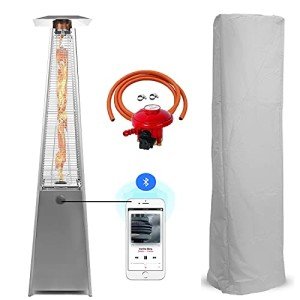The Greatest Sources Of Inspiration Of Patio Heating
Buying Gas Radiant Heaters: A Comprehensive Guide
Gas radiant heaters have acquired popularity over the last few years for their efficiency and capability to offer immediate warmth. As more house owners and businesses look for methods to keep their spaces comfortable, understanding the features, advantages, and considerations when acquiring these heating systems can be extremely useful. This article dives into the intricacies of gas radiant heaters, helping prospective purchasers in making notified decisions.
What are Gas Radiant Heaters?
Gas radiant heaters are devices that utilize propane or natural gas to produce heat directly into a room. Rather than heating the air, they warm items and people in their vicinity, offering convenience more quickly and efficiently. These heaters are popular for both indoor and outdoor settings due to their versatility and effectiveness.
Key Features of Gas Radiant Heaters
- Direct Heating: Unlike standard heaters that warm the air, gas radiant heaters supply direct heat, making them an efficient choice for quickly warming up areas.
- Portability: Many designs are available as portable systems, permitting them to be quickly moved from one area to another.
- Fuel Variety: Gas radiant heaters can be powered by gas or propane, giving users flexibility based upon availability and choice.
- Adjustable Settings: Most gas radiant heaters come with adjustable heat settings, allowing users to customize the level of heat based on their needs.
Benefits of Gas Radiant Heaters
- Energy Efficiency: These heaters convert gas into heat effectively, leading to lower energy expenses compared to electrical heaters.
- Quick Heating: Radiant heat is felt almost immediately, making these heaters suitable for unexpected temperature drops.
- Low Maintenance: Gas radiant heaters generally require less upkeep than electric designs, making them a hassle-free choice.
- Environmentally Friendly: When powered by clean natural gas, these heaters can be a more environmentally sustainable option compared to other heating methods.
Kinds Of Gas Radiant Heaters
When it concerns picking a gas radiant heater, it's vital to understand the various types available. Below are the most common options:
- Indoor Gas Radiant Heaters: Designed for indoor areas, these heaters are typically vented or unvented and frequently included built-in safety functions.
- Outdoor Gas Radiant Heaters: Commonly used in patios or outdoor dining locations, these heaters are designed to endure the aspects.
- Wall-Mounted Gas Radiant Heaters: A space-saving choice, these units are ideal for smaller sized areas and can be outfitted with various heat outputs depending upon the area's needs.
- Freestanding Gas Radiant Heaters: These portable designs can be utilized in various locations, best for those who need versatility.
Buying Guide: How to Choose the Right Gas Radiant Heater
When purchasing a gas radiant heater, numerous aspects must be thought about to guarantee you pick the best design for your space:
1. Heating Capacity
- Measured in BTUs (British Thermal Units), the heater's capability figures out just how much area it can efficiently warm. Buyers should examine their particular needs based on space size.
Room Size (sq feet)
Recommended BTUs (for Gas Radiant Heaters)
100 – 200
5,000 – 10,000 BTUs
200 – 400
10,000 – 20,000 BTUs
400 – 600
20,000 – 30,000 BTUs
600 – 800
30,000+ BTUs
2. Kind of Gas
- Consider whether you will be using propane or natural gas, as different heaters accommodate various fuel types.
3. Security Features
- Look for designs geared up with safety functions such as automatic shut-off valves, tip-over defense, and oxygen deficiency sensing units.
4. Installation Requirements
- Some heaters might require expert installation, especially vented models. Make certain to think about the expenses and requirements related to installation.
5. Portability
- If flexibility is important, consider portable models that can be easily moved from one area to another.
Installation and Maintenance
Gas radiant heaters are generally uncomplicated to install, particularly portable models. Nevertheless, vented options might require professional setup to guarantee they meet regional security codes.
Maintenance usually involves:
- Regular cleaning to avoid dust buildup.
- Inspecting gas connections and fittings for leakages.
- Guaranteeing security functions are functional.
Tip: Regular checks around the unit can assist extend its lifespan and maintain security.
Frequently Asked Questions (FAQs)
Q1: Are gas radiant heaters safe for indoor use?A1: Yes
, as long as they are properly vented and geared up with necessary security functions, they can be securely used inside your home.
**Q2: Can gas radiant heaters be utilized in enclosed spaces?A2: Unvented gas heaters can present dangers in enclosed areas due to potential suffocation or carbon monoxide buildup. Always make sure enough ventilation. Q3: How do I know what size heater I need?A3: The suitable size depends on the location you intend to heat. Describe the BTU chart
above to determine your needs. Q4: What is the distinction in between propane and gas heaters?A4: The main distinction lies in their energy source
**; propane is provided via tanks, while natural gas is generally piped into homes. fireplacesandstoves.uk : How can I make the most of efficiency?A5: Ensure the heater is properly sized for your space, keep it regularly, and think about utilizing it in mix
**with other heating approaches for optimum convenience. Gas radiant heaters can be an excellent addition to any home or organization, providing energy-efficient and quick heating solutions. By comprehending the different types, functions, and factors to consider
when buying, purchasers can make educated choices that meet their heating needs. With the right choice, these heaters supply comfort, dependability, and an inviting environment during colder seasons.  ******
******